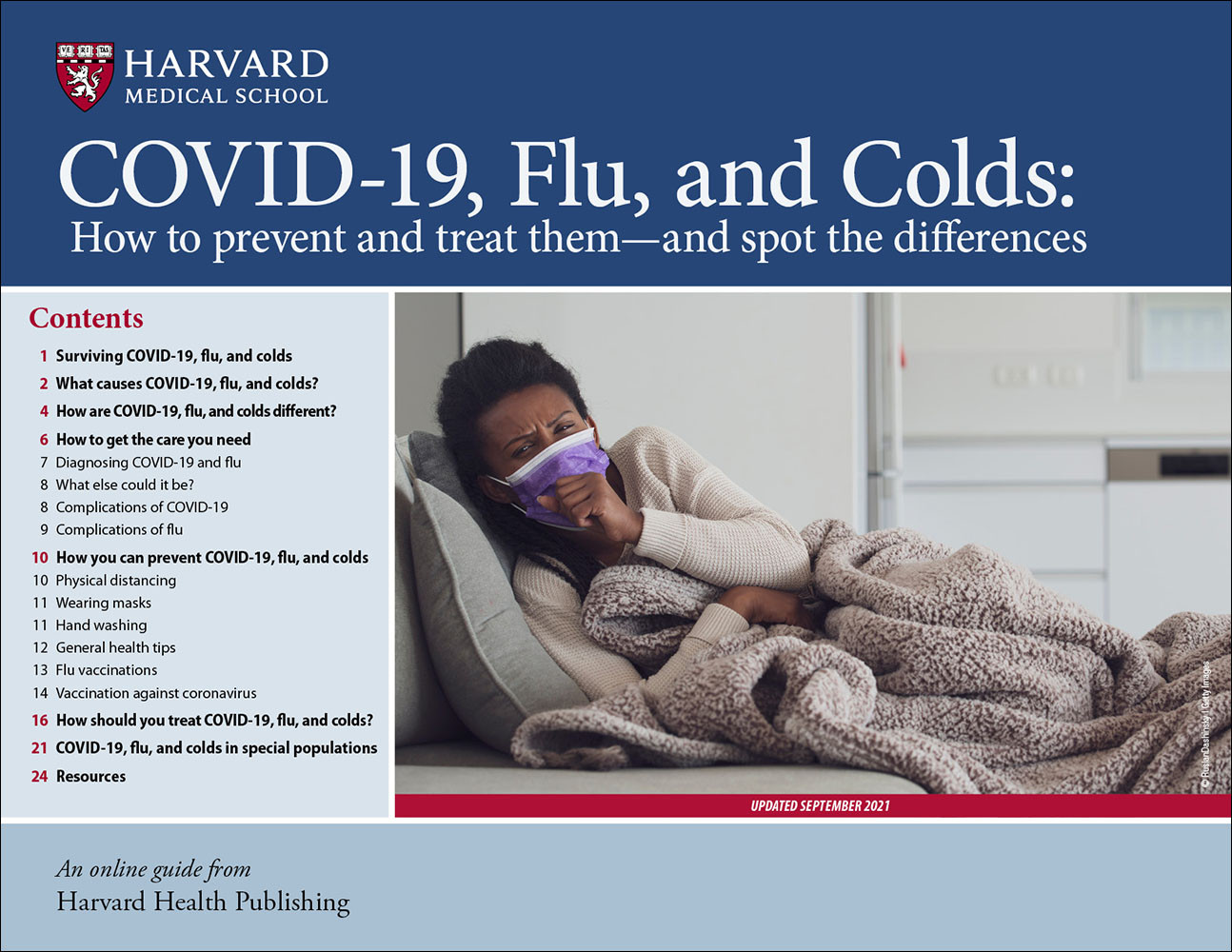
What is a PSA test and how is it used?

Blood sugar–friendly fruits if you have diabetes

Gratitude enhances health, brings happiness — and may even lengthen lives

Respiratory health harms often follow flooding: Taking these steps can help

Could tea tree oil help treat acne or athlete’s foot?

Hemoglobin A1c (HbA1c): What to know if you have diabetes or prediabetes or are at risk for these conditions

What could be causing your blurry vision?

Avocado nutrition: Health benefits and easy recipes

Swimming lessons save lives: What parents should know

Preventing and treating iliotibial (IT) band syndrome: Tips for pain-free movement


COVID-19, Flu, and Colds: How to prevent and treat them — and spot the differences
Any given year, we’ll collectively come down with one billion colds and up to 45 million cases of flu, while the number of new cases of COVID-19 keeps rising. In this guide you will learn how to avoid getting any of these three viral infections, and, if you do get sick, what you can do to feel better. You’ll also learn when your condition is serious enough to call a doctor. The report also provides specific information about high-risk groups for whom COVID and the flu can be very serious.
Other Product Information
Every fall and winter, Americans go through the same coughing, sneezing, and sniffling routine. During any given year, we’ll collectively come down with one billion colds and up to 45 million cases of flu.
The viruses that cause colds can make us miserable for a few days, but rarely lead to any serious health issues. It’s a different story for the influenza virus. It can put you in the hospital even if you are healthy, but it’s especially dangerous for young children, adults over age 65, and people with underlying conditions like heart disease, diabetes, and cancer. But since we’ve been dealing with the flu for more than a century, we have vaccines and antiviral treatments to help combat it.
Over the past year, a more dangerous viral disease has emerged. In December 2019, cases of pneumonia caused by a new virus were first reported in Wuhan, China. That virus is severe acute respiratory syndrome coronavirus 2 (SARS-CoV-2), and the illness it causes is called COVID (short for “coronavirus disease”) 19 (short for the year in which it started). COVID- 19 quickly spread around the world. On March 11, 2020, the World Health Organization (WHO) declared it a global pandemic.
About 80% of COVID cases are mild, or even symptom-free. It’s the 20% of more severe cases that are most worrisome. While COVID can be lethal for anyone, the risk of death is much higher for older people and those with underlying health conditions.
Research on the new coronavirus is still evolving, as is the search for treatments and a vaccine. But there are strategies to help you avoid infection in the meantime. In this guide, you will learn how to avoid getting any of these three viral infections, and, if you do get sick, what you can do to feel better. You’ll also learn when your condition is serious enough to call a doctor. The report also provides specific information about high-risk groups for whom COVID and the flu can be very serious.
Prepared by the editors of Harvard Health Publishing in consultation with Howard E. LeWine, M.D., Assistant Professor of Medicine, Harvard Medical School. 22 pages. (Sept, 2021)
About Harvard Medical School Guides
Harvard Medical School Guides delivers compact, practical information on important health concerns. These publications are smaller in scope than our Special Health Reports, but they are written in the same clear, easy-to-understand language, and they provide the authoritative health advice you expect from Harvard Health Publishing.
How do these viruses spread?
The main way that viruses spread from person to person is through the tiny droplets that sick people propel when they cough, sneeze, or talk. These droplets can fly six feet or more in the air, and they can spread the virus if they deposit on someone’s mouth or nose, or they get inhaled into a person’s lungs. It’s also likely that the new coronavirus becomes aerosolized, remaining suspended in the air for a period of time and drifting farther than six feet, which makes mask wearing and physical distancing (often called social distancing) imperative to preventing spread of the virus.
In the case of coronavirus, an infected person doesn’t need to show symptoms to spread the virus. In fact, the Centers for Disease Control and Prevention (CDC) estimates that 40% of virus transmission happens before infected people show symptoms. After people are infected, they can have no symptoms for several days, or for the duration of their illness. With a cold, you’re contagious the entire time you have symptoms, but you’re most contagious right after you catch the infection, before you have symptoms. With flu, you’re most contagious from the day before your symptoms start until about the fifth day of symptoms. With any of these illnesses, it’s important to stay home when you or your child is most infectious.
- Surviving COVID-19, flu, and colds
- What causes COVID-19, flu, and colds?
- How are COVID-19, flu, and colds different?
- How to get the care you need
- Diagnosing COVID-19 and flu
- What else could it be?
- Complications of COVID-19
- Complications of flu
- How you can prevent COVID-19, flu, and colds
- Physical distancing
- Wearing masks
- Hand washing
- General health tips
- Flu vaccinations
- The hunt for a coronavirus vaccine
- How should you treat COVID-19, flu, and colds?
- COVID-19, flu, and colds in special populations
- Resources

What is a PSA test and how is it used?

Blood sugar–friendly fruits if you have diabetes

Gratitude enhances health, brings happiness — and may even lengthen lives

Respiratory health harms often follow flooding: Taking these steps can help

Could tea tree oil help treat acne or athlete’s foot?

Hemoglobin A1c (HbA1c): What to know if you have diabetes or prediabetes or are at risk for these conditions

What could be causing your blurry vision?

Avocado nutrition: Health benefits and easy recipes

Swimming lessons save lives: What parents should know

Preventing and treating iliotibial (IT) band syndrome: Tips for pain-free movement
Free Healthbeat Signup
Get the latest in health news delivered to your inbox!
Sign Up